Chapter 10
Game Design Theory
There is no sure-fire way to predict whether a game will be successful,
but there are certain attributes that contribute to success. Certainly a
game should have a goalwithout one, what is the point in playing? Rules
should be straightforward and logical. The game should also be a
challenge; if it requires no skill, you will quickly tire of it. A game
should evoke either fantasy or your innate curiosity; if it isn't novel or
puzzling, it becomes boring. And lastly, arcade games, that by definition
have a lot of action, should be easily controllable.
Game objectives take two different forms. There are games where you
gradually approach the goal, like destroying a fleet of invaders in
Galaxian, eating all the dots in Pac Man, or rescuing all of the hostages
in Choplifter. There are other games where the goal is to avoid
catastrophe. Examples of this range from preventing a nuclear power plant
meltdown in Scram, to saving your cities during a nuclear missile attack
in Missile Command, or preserving all of your fuel canisters in Ripoff. Do
not confuse these two kinds of game objectives with the simplistic and
mindless act of scoring lots of points by shooting everything that moves.
Goals must suit a player's expectations or fantasies. This is why
certain people like certain types of games better than others. The battle
lines of good against evil lurk in the background of many space games,
wherein evil, menacing invaders are bent on the destruction of Earth. It
becomes the player's goal to protect the Earth as long as possible while
scoring the most points for killing aliens. Other appealing goals range
from accumulating the most treasure while exploring a dangerous cavern, to
escaping from a crumbling building before it collapses or your food runs
out.
Computer game fantasies derive some of their appeal from the emotional
needs they satisfy. Different fantasies appeal to different people.
Sometimes the fantasy is simply an adolescent emotional release as in Food
Fight, where you battle piethrowing chefs with tables full of messy food.
The fantasy of destroying objects during a game appeals to others. It can
take the form of popping balloons by bouncing a clown off a teeter-totter,
as in Clowns and Balloons, or breaking out bricks in a wall, as in
Breakout. In each case, the partially-destroyed wall or rows of balloons
presents a visually compelling goal and a graphic scorekeeping device as
well.
Goals in most games imply an end point, either when the goal is reached
or when you fail, It is often important to make sure the game doesn't just
go on and on forever. Limits should be set. Sometimes these take the form
of time limits or constantly diminishing amounts of ammunition, balls, or
ships. The most widespread limiting factor, at least on home computers, is
speeding up the game. it is also the most abused. A game tempo, where it
is neither humanly nor mechanically possible to withstand the onslaught of
the computer's forces, cheats the player.
For a game to be considered challenging, it should have a goal where
the outcome is uncertain. If the player is certain to reach the goal or
certain not to reach it, the game is unlikely to present a challenge, and
the player will lose interest. It is very easy to introduce randomness
into the game either by hiding important information or by introducing
random variables that draw the player toward disaster. Be careful not to
overdo this, since a totally random game lacks a skill factor. Players
quickly discover that they have no control over the outcome.
One of the more important design elements in any game is a logical set
of rules. The rules can be extremely simple or utterly complex, but they
must make sense. Since the game must follow its theme, any rules or
variations should stem directly from that theme. It is pointless to throw
in game elements that simply don't belong just because you think that
confusing the player would make the game more difficult. For instance,
Donkey Kong, one of the best jumping, climbing arcade games, doesn't
require the player to shoot everything in sight, just avoid obstacles to
reach the goal. Similarly, a tough, shoot-'em-up game like Galaxian keeps
its fluid alien attack uncluttered by distracting game elements.
A game like Galaxian is considered asymmetric. It is not a balanced
game because both the player and the computer's alien fleet are unbalanced
in strength. Yet the differences between the advantages and disadvantages
of the two opponents are too similar to build triangular relationships
that make an arcade game more interesting.
The triangular relationship is one in which each opponent can defeat
one other or be defeated by the third. The relationship is often used in
many games to lure the player into a trap by sacrificing a weakly-armed
player. Battlezone is a good example. The computer maneuvers the saucer to
entice the human into a poor position against the tank. Time Pilot lures
you into a poor position more subtly by placing the bonus parachute
directly in line with the incoming enemy fighter pack. Other games use the
bonus to distract you. Sky Blazer nearly always drops a fuel canister just
at the time that your target appears, and bomb targets come up in Xevious
just when you are engaged in a heavy fire fight with the alien armada.
A variable difficulty level is often used to alter the game's level of
play. These levels, often with ego-satisfying names like Star Commander or
Pilot, can be set by the player. Many games are designed to become harder
the further you progress. The increasing skill level requirement presents
an added challenge, while preventing the player from growing complacent.
Often the technique is to speed up the game or place additional enemy
craft into battle. The player is required to play faster and better,
honing his reflexes during the process. Another variation allows less time
to complete your objective as the difficulty increases.
Care must be taken so that the game's level of difficulty progresses
evenly from beginner to expert level, Players' scores should reflect a
steady improvement in what is known as a positive monotonic curve. A game
with a relatively flat curve is hard to learn, while a sharp jump means
that there is some trick required to master the level. Games that don't
have a positive monotonic curve frustrate players because they fail to
provide reasonable opportunities to better one's score.
Any good game should offer a reward for reaching increasingly.
difficult levels of play. Often, bonus points, extra balls, ships, or more
ammunition are rewarded for exceeding score thresholds. It is important
that the rewards for winning outweigh the disappointment of losing. A
player's ego is involved. A person wants to beat a challenging game, not
be humiliated each time he loses.
The ideal arcade game should foster the illusion of winnability at all
levels of play. One important factor is a clean and simple game design.
Too much detail or too many rules may intimidate the player. If a player
believes that his failure was caused by a flaw in an overly complex game
or by the controls, he will consider the game unfair and quit. On the
other hand, if a player perceives failure to be attributed to correctable
errors on his part, then he believes the game to be winnable and will play
repeatedly to master the game. It's as if the player teases himself to
play one more time.
Appealing to a player's curiosity effectively keeps a game interesting.
While novelty is sometimes a crucial factor in the original purchase, if
the game has little depth, it becomes repetitious and boring. One method
that appeals to many game designers is to have the game progress to
slightly different scenarios. Some games change the opposition, while
others vary the scenery; some do both. The player has to excel if he is to
satisfy his curiosity. Games like Threshold, which progresses through
twenty-four sets of alien spacecraft, or Vanguard, in which both the
scenery and alien craft changes, offer strong curiosity incentives.
These spurs to a player's interest in the game are called "Perks." They
are most important just when the player thinks he has the game figured
out. Perks must be carefully timed so that the player does not give up on
the game because not enough happens soon enough or because everything the
game has to offer has been seen too soon. The most common perk is an extra
life. Consider these coin-op video games: Pac Man, Donkey Kong, Dig Dug,
Joust, Marto Bros., and Tempest. These games have multiple screens. The
different screens by themselves are a perk, but what these games have in
common is the time at which an extra life is rewarded. The extra lives
generally come to the average player at some point in his third screen.
This is hardly coincidental. The screens are scheduled at a specific rate,
somewhat dependent on the player's skill. The extra life on the third
screen comes in just before the average player might become exasperated
and so not put in another quarter. The novice player is usually out of
lives at this point, too.
Some games use cartoon intermissions to perk up the game. The player's
interest is renewed with each cartoon. For many players, seeing the next
cartoon becomes a personal goal. Placing hidden features not even hinted
at in the rules is another clever perk. These embellishments are left for
the experienced player to discover. They can even brighten up the earlier
levels of a game which has become dull for the expert. For example, in the
coin-op version of Star Wars, players hear the voice of Obi-Wan Kenobi
admonishing them to use the Force. Nothing in the game instructions tell
them what to do. Only by experimentation will a player realize that he
must fly through the trench without firing a shot to receive a substantial
point bonus upon reaching the exhaust port. The high score feature can
also be considered as a "perk." While it doesn't renew interest within the
game, it is important because it can renew interest in playing even a
mediocre game again. The high score itself presents a personal goal to
reach, whether it be to beat your own high score or someone else's.
Sometimes varying the player's emotional response during the game
serves as a "perk." Tension can be relieved during a tense shoot-'em-up
with occasional comic relief, while cute games sometimes need touching
moments. Remember games as entertainment need contrast. In sum, the
varieties of perks are endless, but their objective is the same: renew
interest in the game before the player becomes tired of it.
A game's controllability is one of the more important considerations in
design. It is sometimes referred to as human engineering. Designers
usually choose between keyboard and paddle/joystick control. While
eye/hand coordination is more effective with paddles or joysticks,
programmers attempting to create games with too many control functions
will opt for a keyboard control system. At times, they produce a game that
requires nine or ten keyboard controls which, unfortunately, only a
pianist can operate. Games whose controls require considerable time to
master often prove frustrating to play.
The ability to accurately control the action is crucial in the I
design. If the screen does not respond immediately to the player's input,
the player may end up feeling out of sync and become frustrated with the
game. The programmer must insure through careful design that the game
responds properly to the player. The player shouldn't believe, for
example, that the computer made a wrong turn for him in a maze game.
Apparently, Atari owners like games which pit them against a
competitive computer opponent. In several multi-player games, groups of
two or more simultaneously compete against each other. Most of these
contests are sports or card games involving two to four players. The
cooperative game is rarely seen, except in cases where the computer
competitor is much too skillful. The arcade game Ripoff involves a
computer opponent that is more than a match for two players playing
simultaneously. The battle is so fast and fierce that the teammate's ship
has to be protected from his partner's bullets. The home computer version
of Wizard of Wor offers a choice of competitive or cooperative play. It is
a tough game that really needs cooperative play if the more advanced game
levels are to be reached, but cooperation in this game is by agreement,
not by mutual invulnerablity. Your partner is even worth 1000 points if
you mistakenly blunder. It is quite interesting to watch cooperation turn
into a fiercely competitive game after one player inadvertently walks into
the other player's line of fire.
So far, we have discussed theory and generalizations that should
increase a game's playability and appeal to the public. Concrete examples
of the more popular games should give you a much more solid foundation for
your own designs.
Example Arcade GamesSpace Invaders was the first really popular
arcade game. The object is to defend your turf against an alien horde of
ferocious invaders who attack your castles and gun bases with a barrage of
undulating bullets. It is actually a timed game, since you only have a
limited period to destroy the entire attacking wave before they descend to
the ground in marching formations and overrun your lone gun base.
The elimination of each alien acts as a visual scorekeeping device. You
can never win, only survive as long as possible (thus getting the maximum
playtime for your quarter). Elimination of each attacking wave, however,
is an intermediate goal that staves off your inevitable doom. Each
successive level becomes more difficult since the aliens, which begin
their attack increasingly closer to Earth each round, limit the amount of
time that you have to destroy them. Their constant approach to your mobile
gun base decreases the reaction time needed to avoid enemy fire.
Shoot-'em-up games like Sneakers, Galaxian, Threshold, and Galaga are
actually spin-offs of the Space Invaders theme. Whether they are set in
space or on the ground, each has a variety of targets bent on your
destruction. The targets or attackers are no longer static. Either they
appear to dodge your fire, or they resort to kamikaze-type attacks.
The strong appeal of these types of games is based on curiosity and
game depth. You are inspired to do better with each game just to see what
the attackers are going to look like in the next level and what their
tactics might be. The design goal is variety, with each successive level
slightly harder than the last. Although most offer an unlimited number of
bullets, Threshold controls rapid, random, and wasteful firing by
overheating your lasers. Thus, your firing must be more accurate and paced
during the game.
The popularity of Pac Man can be attributed to the game's design.
First, it satisfies the fantasy concept of a person's childhood dreams. As
children, we dreamt that we were being chased by evil monsters or ghosts,
and we felt powerless to stop them. We
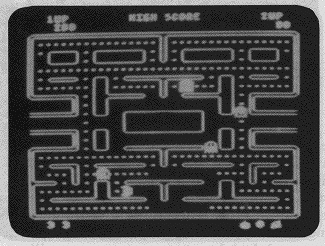
wished that there were some way to turn the tables, if only for a few
moments. Pac Man's four energy dots fulfill that fantasy. The game also
offers the visual feedback of the number of remaining dots to be eaten at
each level. And since clearing each individual level is an immediate goal,
even beginners believe a level can be cleared. Because Pac Man is a game
of consumption rather than one of destruction, it appeals to players of
both sexes.
The game becomes a learning experience for the more advanced player,
since the ghosts follow a discernible, non-random pattern. A player is
eventually able to predict their movements and, consequently, to develop a
technique to clear all of the dots on a particular level. The long term
goal is survival and the highest score. The game is designed so that you
gain more pleasure as you get better. Thus, players are willing to devote
the time and money to master the game.
Scrolling games, such as Super Cobra, Vanguard, and Tail of Beta Lyrae,
wherein your ship travels over a multi-screen world, benefit strongly from
player curiosity and visual variety. Vanguard, a shoot-'em-up game in
which a variety of enemy vessels and creatures attack your ship, has an
extremely long sinuous tunnel with various types of chambers. The game has
so many sections, combined with scrolling directions which change from
horizontal to diagonal to vertical, that it is like playing many different
arcade games at once. The player is given the option several times during
the game to enter battle with a time-limited, energized spacecraft
equipped for ramming the enemy, or merely four plain, old directional
lasers. A map displayed in the lower corner informs the player of his
progress. The curiosity factor is so enticing in this game that thirty
seconds are provided to lure you into inserting another quarter in order
to continue from where you left off.
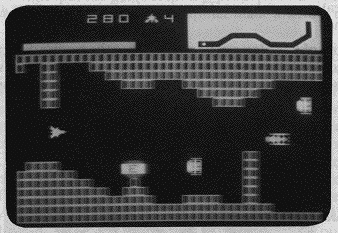
Super Cobra is a classic game wherein you fly a helicopter over
scrolling alien terrain and through heavily fortified and obstacle-filled
narrow tunnels. Initially, you have to survive ground-launched rockets and
a few laser bases, but as the game progresses you must also contend with
meteors and alien ships. Using either your bombs or lasers to clear the
tunnels of protruding ground targets is crucial to your survival. Bombing
accuracy is also important. If you don't replenish your fuel supply by
hitting enough fuel depot targets, your game will soon be over.
Pole Position, a highly competitive game, appeals to many players
because it mixes just the right amount of fantasy with reality. It
fulfills the fantasy of being a race car driver without the inherent
danger. Crashes are never fatal and do not end the game. The goal of the
game is to qualify for and complete the race. In a sense, it is a very
realistic simulation requiring shifting gears and precise steering on a
scrolling roadway. The player has a three-dimensional view of the course
and his car, as if he were following it from fifty feet behind, a sort of
out-of-body effect.
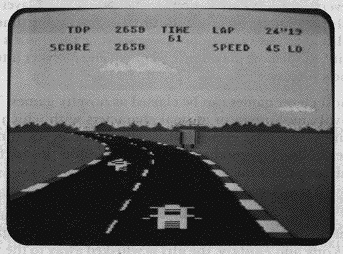
Joust immediately comes to mind when discussing a pure fantasy game
that traces its roots to the glamorous days of medieval chivalry. Instead
of presenting two knights in shining armor dueling on horseback, Joust
allows the player to fly his ostrich-like mount to do battle in midair.
The player does not shoot his opponents but defeats them by ramming his
mount and lance into theirs, sometimes delicately, sometimes violently.
The higher mount always wins. The player gains the excitement of physical
contact without a bloody nose.
The game constantly forces the player into action. He must keep hitting
the action button to make his mount fly. When the player takes a short
rest between screens, his
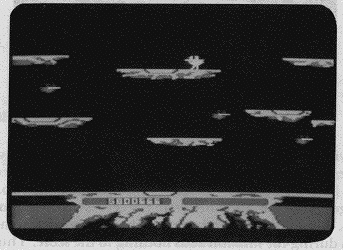
surrogate also rests and does not continue to fly along aimlessly as it
might in other games. Two players can play simultaneously but are not
forced into partnership. The Lava Troll on the bottom of the screen is an
additional menace both to the player and his enemies. It attempts to grab
at anything close enough and drag it into the lava. This sometimes works
to the player's advantage, since the lava can imprison an enemy and make
it easier to destroy. A more formidable enemy, the pterodactyl that
appears on higher levels, requires the player to discover a way to defeat
it. As an added perk, every fifth screen is a bonus level where the player
need not fight anyone but simply pick up the eggs for additional points.
Many times this earns the player an extra life or at least a temporary
rest from the game's pace. Physical contact, originality, immediate player
involvement, and monster interaction are key parts of this game's success.
Some of the most clever games can be classed as novelty games. These
are often "cute" games involving human or animal characters with which the
player can identify. These novelty games either follow the theme of
rescuing someone, or require the player to develop good manual dexterity
and precise timing skills in order to avoid catastrophe or the demise of
the hero.
The rescue theme appears in games like Donkey Kong, Donkey Kong Junior,
Fantasy, and the Adventures of Roby Roto. In many cases an actual rescue
doesn't take place, but the theme carries the player from one portion of
the game to the next. In both Donkey Kong and Fantasy, the girl is whisked
away to the next screen just before the player reaches her. The objective
isn't the rescue but to overcome the obstacles barring your way. Learning
the patterns and precise timing through repeated play hones the player's
skill.
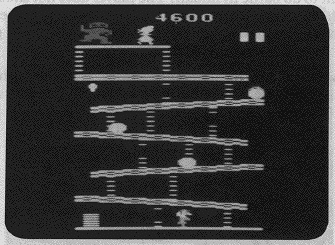
Although playing the hero is rare in these games, two games have
followed this theme: The Adventures of Roby Roto in the arcade, and
Choplifter on most microcomputers. The latter is probably the purest in
theme of the two. The rescue of sixty-four hostages is the one and only
goal. Success is measured in the number of hostages rescued. The fact that
the player may have destroyed twenty-seven enemy tanks and planes during
the mission adds nothing to the score. Thus, while details
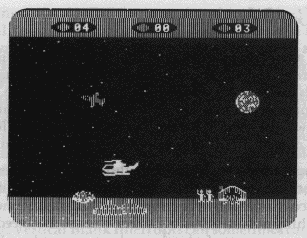
like the hostage's waving builds empathy for the hostages, the appeal
is simply the ego-satisfying role of playing the hero.
In the final group of novelty games, the player must avoid the calamity
of losing a life. The goals and obstacles in these games differ widely.
Crazy Climber requires the player to scale a building while windows close
to block the path, and angry tenants, attempting to knock the climber off
the building, drop flower pots on his head. Frogger has the player brave
traffic in a test of precise timing skills. And playing Tarzan in jungle
Hunt requires dexterity and timing skills to swing from vine to vine like
a trapeze artist, or risk death in the fall. In each of these games the
cuteness is what first attracts the audience, but it is the development of
the player's timing skills and game depth that keeps him playing. Again,
the concept is variety, along with increasing levels of difficulty.
Arcade games have that indefinable ability to make you feel that your
losing is just a fluke, and that if you play just one more time, you'll
beat it. If you can design a game that is fun and exciting to play, and
has that added quality, then you have designed an addictive game, and
wealth beyond your wildest dreams may be yours.
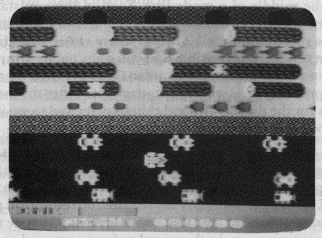
What Can Go WrongThe best piece of advice that we can give a game
programmer is to carefully plan out your game before you begin programming
it. First decide what results you want and work backwards to figure out
what you have to do to get them. If it doesn't work, change your concept
or goal until you get something you are satisfied with. Make sure the game
follows real-world physical principle, so that it feels right on a gut
level. For example, objects smash or bounce when they fall from any
height.
Many novice programmers try to get something up on the screen
immediately. Actually, there is nothing wrong with this technique. After
all, it does give you some encouragement to continue. However, most
develop their games on a piecemeal basis, adding something because it
looks good or because they need more action. The result is that they soon
run out of players or characters and are forced to do a very painful
rewrite.
Everyone prefers to organize his game differently. Some, like me,
prefer the tight- structured approach of a flowchart; others, like my
partner, just write down a rough outline of the order of events in the
game. Whichever approach you prefer, we strongly recommend that you
develop many of your frequently used routines as independent subroutines.
This approach simplifies the logic of the main code loop.
We carefully planned all of the games in this book before we wrote
them. This means that we considered where items like screen memory,
player-missile memory, the character set, and the actual game code were
placed in memory. We roughly flowcharted the game's main logic loop. We
then wrote the code in small chunks, but in such manner that it always
ran, or at least was supposed to run.
The first priority was to draw the playfield. This generally means that
we had to get the display list right and move the character set data into
the correct section of memory. It may sound like a piece of cake, but some
terrible things can go wrong. Sometimes the display list is too long
because you forgot that the first LMS instruction is one of the mode
lines. The screen rolls or goes wacko. Maybe you let the display list
inadvertently cross a 1K boundary, or allowed screen memory to cross a 4K
boundary in the middle of a mode line. Each of these mistakes can cause
the screen to behave erratically. If you do get a stable display, and it
isn't the one you specified, perhaps you forgot to tell ANTIC where either
your display list or your RAM character set resides. It is possible that
you didn't place your character set on a 1K boundary, or on a 1/2K
boundary if you are in GR. 1 or GR. 2. The fastest method to troubleshoot
the problem in Assembly language is to enter the monitor and look at the
intended areas for the display list and character set and to see if they
are actually there. It is quite possible your memory move routine is
faulty.
The next step is usually to initialize the starting positions of your
players. Sometimes they just don't appear, so you immediately check to see
if the player shape is actually in the proper 256 bytes of player-missile
memory. You should also check that the PMBASE is on a 2K boundary for
singleline resolution players (1K boundary for double-line resolution),
and that you told ANTIC where that is. If that isn't the fault, some
programmers make the mistake of trying to read a player's horizontal
position by looking at the ANTIC horizontal position register. You may be
able to write a horizontal position to the hardware location, but you read
collisions from these same hardware locations. If you are going to
increment a player's horizontal position, you will need to update a RAM
location before writing the value into the hardware register. If this
doesn't appear to be the problem, there are two other possibilities.
First, you may have forgotten to turn on player-missile graphics switches.
But probably the most frequent mistake is to forget to set the player's
shadow color register. If it isn't set, it defaults to the background
color, blends in with the background and disappears. Always use the shadow
color register to change or set color registers, or the change may only
last one television frame because the hardware registers are updated every
VBlank. The only exception to this rule is when you use a Display List
Interrupt to change colors midscreen.
Display List and Vertical Blank Interrupts can sometimes cause
unforeseen problems. Inexperience is usually the culprit. The first thing
to remember is that you must have a program to interrupt from. Since it is
easy to write a simple game entirely in Deferred Vertical Blank, the main
loop can be as short as FOREVER JMP FOREVER. The machine will hang up if
you don't have somewhere to jump back to at the end of the VBI. On the
other hand, if the code is too long, it will be interrupted by the next
VBlank before it finishes. Unexpected results, such as a garbaged screen,
may occur. The most common problems with Display List Interrupts occur
when you forget to save your registers before entering the routine or
forget to restore them before exiting. A mistake here will lock up the
machine. The other problem is when the interrupt seems to occur on the
wrong mode line. Remember that the interrupt has to be set on the mode
line before the interrupt is to occur.
BASIC programmers who use Machine language subroutines sometimes
encounter strange problems. If you are going to incorporate a VBlank
routine, make sure you clear the decimal mode at the beginning. This is
especially important if your program uses decimal arithmetic internally.
Another problem occurs when you pull the incorrect number of bytes off the
stack. This can lock up the machine on the return if the return address on
the stack is incorrect. Unfortunately, these subroutines are very
difficult to test in Assembly language without constructing a setup
routine to simulate the stack environment.
BASIC is usually very forgiving, so it is unlikely that you will lock
up the machine if you aren't using Machine language subroutines. One of
the most common display mistakes is forgetting to set a graphics mode
after you lower RAMTOP to reserve space for your RAM character set and
player-missile graphics. If you forget, you will still have a Graphics 0
display just below the old RAMTOP. The new graphics call will actually
place the screen below RAMTOP.
We hope we have suggested adequate solutions for the most common errors
that might occur in your games. We have learned many of these by bitter
and frustrating experience. We will admit that these weren't the only
errors that we encountered when programming the code in this book.
However, most of the others were logic problems that one of us alone
couldn't trace. For example, when I was programming the maze game, I
programmed the manual mode for the joystick-controlled letter first. It
worked fine, but became buggy when I added the auto mode. Sometimes the
letter would behave properly, yet at other times it would escape the maze
walls. I single-stepped the code repeatedly and the legal move flags were
always set correctly. Days went by and I couldn't find any cause for the
anomaly. My partner discovered that it only happened just after the stick
was returned to neutral. While legal moves were reset at the center of
each maze block, moving the stick was required to close pathways other
than those in the direction of movement or in reverse. Nothing was done in
the neutral position because the letter was stopped in the non-auto mode.
Since I had neglected to close gates when I was in the neutral position,
the joystickcontrolled letter was now traveling in some direction
automatically, so it became possible to give it a new direction command
while it was between blocks. For example, if it had just passed a block
that said it could go right, pushing right from the neutral position would
command it to go right even though there was a wall there. In short, I
forgot to close gates when I was in the auto mode, because I assumed they
were set by one of the four non-neutral positions. This is a fine example
of misguided thinking.
In closing, we hope that we have provided you with enough programming
techniques and game theory to create your own arcade games. Remember that
originality, persistence and attention to detail are the keys to success
in this industry. We hope some of our readers will join the ranks of
successful Atari game designers. If you take the easy way out and program
a quick game, the results will show in mediocrity.
Return to Table of
Contents | Previous
Chapter | Next Chapter
|



